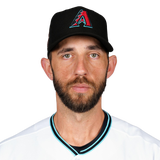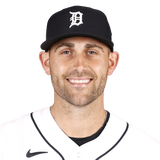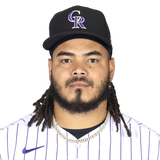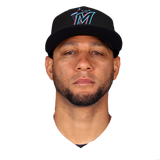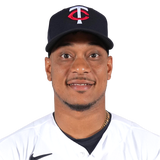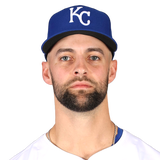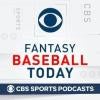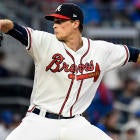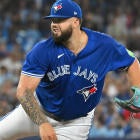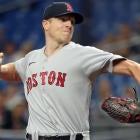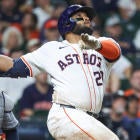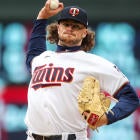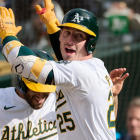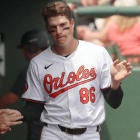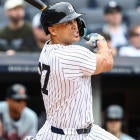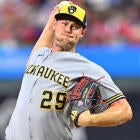Circumstances have changed since our first round of draft prep. We're working with a much shorter schedule now, which of course changes the way certain players are valued. It was always the year of the pitcher, with the most skilled at that position enjoying a bump in value at a time when offense dominates the game. But now, even those with workload limitations are able to join in.
Consider this your reintroduction to the 2020 draft pool, accounting for all the changes that have taken place since and because of the coronavirus lockdown. Over the span of 20 articles, Scott White and Chris Towers look at the top 200 in Scott's Rotisserie rankings, highlighting the reasons for and against drafting each. It makes for a well-rounded education on every player, revealing critical details that more argument-based evaluations might conveniently leave out.
So if you want a crash course on this year's player pool, particularly in light of more recent events, you've come to the right place. We're going through Nos. 131 through 140. And you can find the rest right here: 1-10 | 11-20 | 21-30 | 31-40 | 41-50 | 51-60 | 61-70 | 71-80 | 81-90 | 91-100 | 101-110 | 111-120 | 121-130 | 131-140 | 141-150 | 151-160 | 161-170 | 171-180 | 181-190 | 191-200
No. 131-140
| ||||||||||
The Case For: Urias was the top pitching prospect in baseball all the way back in 2016, so it might shock you to learn he is still just 23 years old. To put that into context, he's nearly two years younger than 2019 NL Rookie of the Year Pete Alonso. He's a full year younger than A.J. Puk, the Athletics prospect. We haven't seen Urias stand up to a full-time starter's workload yet, but he's thrown 184 innings in the majors with a 9.2 K/9, 3.18 ERA, and 1.28 WHIP, which would be a pretty good outcome. He also added 2 mph to his fastball last season and sported a strong 13.7 swinging strike rate. That was largely in relief, but it points to the kind of upside Urias has.
The Case Against: What kind of workload is he looking at? Surely, the shortened season assures he won't get shut down, but will he mostly be limited to 4-5 innings? The Dodgers have a rotation surplus, so particularly with expanded rosters, they could have Urias share his turn in the rotation, creating sort of a piggyback situation rather than using him like a traditional starter. Does it really make sense to draft a player for his ceiling when it's that unlikely he reaches it? Urias could end up one of the best pitchers in baseball, but it's a lot more likely that comes in 2021 or beyond, if it ever does happen. -Chris Towers
| ||||||||||
The Case For: Bumgarner showed signs of slowing his decline in 2019, which should bode well for his chances of aging well. After two injury-plagued seasons, he was back to being a workhorse and saw his strikeout rate improve to its best mark since 2016. He actually posted the second-best swinging-strike rate of his career and saw his average fastball velocity return to pre-injury levels. Bumgarner is no longer an ace, but he's not washed up, and a better supporting cast in Arizona could lead to much better things.
The Case Against: It's not surprise that Bumgarner has pitched better in his career at home than on the road, but the splits are especially alarming in recent years — a 5.29 ERA in 2019 on the road, and a 4.97 mark in 2018. Chase Field is no longer the hitter's paradise it was before the installation of the humidor, but it's no Oracle Park, still arguably the best place to pitch in baseball. That could have been papering over his true level of regression, and it might mean Bumgarner isn't even worth starting in 2020. -Chris Towers
| ||||||||||
The Case For: If xFIP means anything to you, then it should also mean something that Fried had the ninth-best in baseball, better than Walker Buehler, Jack Flaherty and scores of others who we already classify as aces. He's a better bat-misser than he gets credit for, ranking 25th in swinging-strike rate, but more notable is his top-five ground-ball rate, giving him a skill set perfectly attuned for an era when home run prevention is paramount.
The Case Against: The expected stats are all well and good, but Fried still had just a 4.02 ERA last year. He was fortunate to win 17 games considering, and it's possible he gets better and still make less of a Fantasy impact just because that victory pace is so hard to repeat. He's heavily reliant on his curveball — an excellent pitch that contributes to both his swinging-strike and ground-ball rates — but his lack of a real changeup makes him vulnerable to right-handed bats, which could prevent him from taking another step forward. -Scott White
| ||||||||||
The Case For: For much of 2019, Boyd looked like a breakthrough ace who had the simple misfortune of pitching for a miserable Tigers team, keeping his win-loss record on the wrong side of the ledger. He continued to up the usage of his slider, a swing-and-miss pitch that largely contributed to him having the eighth-best swinging strike rate in baseball — just ahead of Shane Bieber and Jack Flaherty — and he also had the eighth-best strikeout-to-walk ratio. While a late slump skewed his ERA, his 3.88 xFIP suggests better times are ahead, giving you one last chance to buy in at a discount.
The Case Against: Was it a late slump or, ahem, the majority of his season? Over his first 14 starts, Boyd had a 3.08 ERA and 1.04 WHIP, but over his final 18, he had a 5.81 ERA and 1.39 WHIP, his HR/9 jumping from 1.06 to 2.59. It's the home runs that promise to ruin him again. He's just too vulnerable to fly balls, ranking second in that category at a time when seemingly any ball put in the air has a chance to sail over the fence. -Scott White
| ||||||||||
The Case For: Lamet came back from missing a full season recovering from Tommy John surgery and looked better than ever. He was throwing his fastball a full mph faster than prior to the injury and racked up a massive 14.0.% swinging strike rate and 33.6% strikeout rate. It was only 73 innings, but they were 73 incredibly impressive innings, and you usually can't find this kind of upside at pitcher this late.
The Case Against: Lamet is strictly a two-pitch pitcher, and he has always given up a ton of fly balls. The strikeouts can mitigate the risk of that somewhat, but he's going to struggle to pitch deep into games without a reliable third pitch to give hitters another look, and he might always disappoint as a result. There's upside here, sure, but the floor could be quite low. -Chris Towers
| ||||||||||||
The Case For: Since joining the majors, Gurriel has been one of the league's best contact hitters, and he added some pop to that profile in 2019. Actually, that's underselling it quite a bit — Gurriel became a legitimate power threat overnight. His 31 home runs matched his combined total from the previous two seasons, and he did it without sacrificing any of his elite contact skills. Playing in that lineup, RBI and runs are always going to be plentiful, even more so if Gurriel can create them for himself like he did.
The Case Against: You won't ever go broke betting against a 35-year-old coming off a career season, and in Gurriel's case, it's one of the better bets you can make. Gurriel's breakout isn't backed up by the underlying numbers — he had a higher hard-hit rate in 2017 than 2019, and his average exit velocity was identical to 2018. Additionally, the bulk of Gurriel's production came in one stretch, as he hit 19 of those 31 homers in July and August. He didn't have an OPS over .758 in any other month. You don't have to pay face value for Gurriel's 2019 numbers, but there's still a chance you're spending a mid-round pick on a pretty fringy option if 2019 was a fluke. -Chris Towers
| ||||||||||||
The Case For: Polanco enjoyed a breakout in 2019, but it was mostly just in the power department. He sustained his average gains from 2018, and the batted-ball data backs him up there, too. Polanco will probably never have much more than average power, but his contact skills and the juiced ball will help that play up. So will the Twins lineup.
The Case Against: 2019 was the first time in Polanco's career he has ever had an OPS over .773, and he'd never been much more than a 15-homer guy even when you paced out his partial seasons. If he regresses to that, it's still a viable skill set but doesn't have quite as much upside, especially if the Twins revamped lineup sees him move down the order after batting second for most of 2019. -Chris Towers
| ||||||||||
The Case For: It was apparent even before the Marlins moved him at the deadline that Anderson had a big arm, but the Rays, as they so often do, unlocked its full potential. The transformation was immediate, and it was spectacular. The reliever we saw in those 23 appearances — one who delivered a 2.11 ERA, 0.66 WHIP and 17.3 K/9 — would be the best in the majors, and the Rays are apparently willing to go all-in on him, dealing away their closer, Emilio Pagan, in an offseason trade.
The Case Against: But does it mean Anderson is the closer? You're not going to get an answer from manager Kevin Cash, who has never subscribed to traditional bullpen roles. It's a wonder Pagan so often had his number called in the ninth. There's also the question of how definite Anderson's transformation was, given the sample size. Command was an issue for him prior to joining the Rays. He clearly has the potential to be the top reliever in Fantasy — or at least to rival Josh Hader — but it's a wide range of possible outcomes. -Scott White
| ||||||||||||
The Case For: Schwarber had a noteworthy 2019, quietly clearing some of the hurdles that had been holding him back, and now enters 2020 with the most momentum he's had since he was first breaking into the league. He demonstrated he's no longer such a liability against left-handed pitchers, producing a respectable .756 OPS against them, which should ensure him close to everyday at-bats. He also cut down significantly on his strikeout rate in the second half, when he hit .280 with a .997 OPS. His exit velocity was up, his hard-hit rate was among the top five in baseball, and he underperformed both his xBA (.267) and xwOBA (.375).
The Case Against: Maybe Schwarber is genuinely improving as a hitter, but with most of the production being confined to the second half, it's putting a lot of faith in a fairly small sample. The cost is reasonable enough considering, but you have to remember that even in a best-case scenario, he's only helping in the most plentiful categories, offering little in the way of batting average and nothing in the way of stolen bases. -Scott White
| ||||||||||||
The Case For: All Justin Turner does is hit. Even at 34, he had another productive season, hitting .290/.372/.509, his fifth time in the last six seasons hitting at least .290. Turner really hasn't shown any signs of slowing down, and he's priced appropriately for the production he'll give you when healthy.
The Case Against: At this point, you simply can't assume everyday play for Turner. He missed 27 games and came off the bench for 13 others, leaving him with just 122 starts in 2019, his third straight season below 125. You'll never get big counting stats from him as a result, and you'll also need to keep a regular fill-in around, especially in daily leagues. Is it worth the headache? -Chris Towers










